‘Our actions do not transform the world, they are part and parcel of the world's transforming itself’ – Tim Ingold
‘We are nature defending itself’ – Climate Games activist group slogan
In his book The perception of the environment (2011), anthropologist Tim Ingold critiques a paradigmatic opposition that has long underpinned modern understandings of western civilisation: the opposition of practices of food production (agriculture) to practices of food collection (hunting and gathering). He points out that underlying this opposition ‘is a master narrative about how human beings, through their mental and bodily labour, have progressively raised themselves above the purely natural level of existence to which all other animals are confined, and so doing have built themselves a history of civilisation' (Ingold 2000: 78). While we now recognise the racist logic of modern evolutionist thought, the systematic domination of land and animals remains central to western schema of modernisation. Consequently, we tend not to see the practices of peoples who survived according to a land-based ethic of interdependency and stewardship as equally constitutive of human history. The central injunction of Ingold’s book, one informed by anthropological analyses of many kinds of societies and that applies to both sides of this opposition, is that we properly recognise the ecological character of human ontology. Notwithstanding our cognitive capacity to objectify and set ourselves apart from our world, our subjectivity is formed through our interrelatedness with the human, non-human and material components of our environment. This means that rather than viewing human history as a process by which we have asserted our reason and will upon nature and the other materials of the earth, Ingold urges us to see history as ‘the process wherein both people and their environments are continually bringing each other into being’ (2000: 87).
Ingold’s articulation of the subject-environment relationship is an important spur for addressing our failure to prioritise the health of the globe’s natural systems. It focuses attention, in my mind, on the subjectivities generated by global urbanisation, not only in relation to the concentration of populations in cities (currently approximately half of the global population), but the colonisation of the spaces that exceed urban geographies by the city’s commercial, bureaucratic and technological armature. To state the obvious; the rise of industrial and new knowledge/service/consumer economies has entailed the migration of our livelihoods further and further from the land and, concomitantly, a loss of literacy about what the land requires to sustain itself, and hence ourselves. In many parts of the world, the subject-environment interrelationships that ‘bring each other into being’ have departed so dramatically from those constituted by land-based ethics that it is hard to identify a non-sacrificial place for nature within them. As we become more attuned to these sites of collapse and the bigger picture of anthropogenic climate change, we are forced to confront the fact that ‘modernity is unmaking the stability that enabled its emergence’ (Gibson, Rose and Fincher 2015: vi).
In this article, Ingold’s arguments provide a starting point for considering several art projects that aim to enfold us into more sustainable relationships with the natural resources upon which we rely. I will discuss two Australian projects: Diego Bonetto’s Wild Food Tours and Artist as Family, as well as the Echigo Tsumari Art Triennial in Japan and a project that featured in its 2015 iteration called The Homestay Museum, by Takafumi Fukasawa. These are all socially engaged art projects in one way or another, operating outside the sphere of art institutions and inviting the engagement of the general public. They are also simultaneously retrospective and prospective in orientation. They envisage sustainable futures by revivifying practices of food producing labour that have been largely expelled from urban economies. I will argue that these projects propose a compelling ethic of food decommodification and that they do this by, first, performing and creating encounters with practices of subsistence, and second, by reconfiguring the urban/rural divide as it has been construed culturally and economically through capitalist urbanisation. Through these entwined concerns they target some of the most obdurate impasses to devising environmentally conscious ways of living. My knowledge of these projects is informed by interviews with the artists and, to different degrees, participation.[i]
The projects
Diego Bonetto is a Sydney-based artist dedicated to creating experiences that revolve around the nutritional, ecological and social identities of plants. Born in Italy, his practice has always been inflected by an interest in the way migrant communities ‘enact identity and belonging’ and mobilise ancestral knowledge by engaging with land and plants.[ii] Challenging everyday understandings of good and bad plants, Bonetto reveals how ‘weed’ species were historically valued and continue to be valued elsewhere in the world. He redeems such plants in the public imagination by facilitating sensuous interactions with them (foraging, cooking, eating) in the context of convivial social exchange. He also advocates for a more eclectic and adaptive vision of healthy eco-systems, pointing out that ‘spontaneous flora’ exist because they have found a particular environment to be conducive to their reproduction, and are thus useful as companion plants, to enhance soil health or prevent erosion for example. For several years now Bonetto has conducted participatory ‘wild food’ tours in urban parkland, reserves and waterways, and he also takes people further afield to forage for mushrooms (Gallagher 2012; Safe 2015). These tours equip people with the knowledge to identify edible and medicinal plants that are often abundant in urban landscapes and thus alert people to the availability of food outside the consumer-capitalist complex. He collaborates extensively with ‘chefs, scientists, architects, academics, herbalists, brewers, soap makers, producers, educators and land owners, providing programs, workshops, tours, community engagement strategies and exhibitions’ in an array of contexts (Bonetto 2016).
Artist as Family, the collective name for Meg Ulman, Patrick Jones, their two children and pet dog, live in the rural community of Daylseford, Victoria. As writers, parents, permaculturalists and activists they have adopted a way of life that aims to reshape subjectivity and togetherness around non-reliance on fossil-fuels. In recent years they have cultivated a locavorist way of life (eating food that is only locally sourced), made possible through their communalism with like-minded people in Daylesford and inspired in part by the historic bioregionalism of Indigenous groups in Australia. They characterise their practice as a form of permapoesis or ‘permanent making’ (Family 2016). They reach a variety of communities through both real and virtual exchange via their blog posts, poetry, essays, book readings, workshops and performances. Artist as Family recently travelled 6000 kilometres by bicycle along the East Coast of Australia from their home in Victoria to Cape York. Their journey took over a year and they spent next to no money. Along the way they drew on their extensive knowledge of wild foods to survive by foraging, fishing and trapping, while they also traded their labour for hospitality on farms and were welcomed by many friends and strangers who supported their journey. This journey was recently narrated in the book The Art of Free Travel (Jones and Ulman 2015).
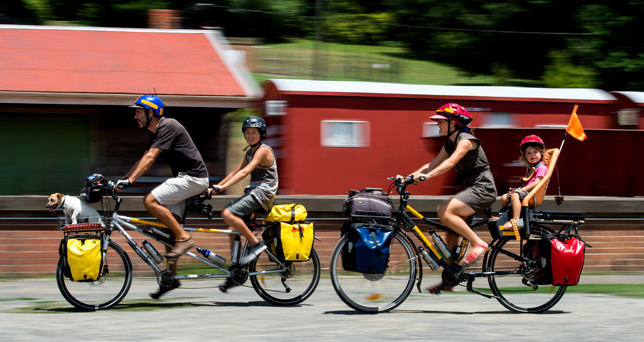
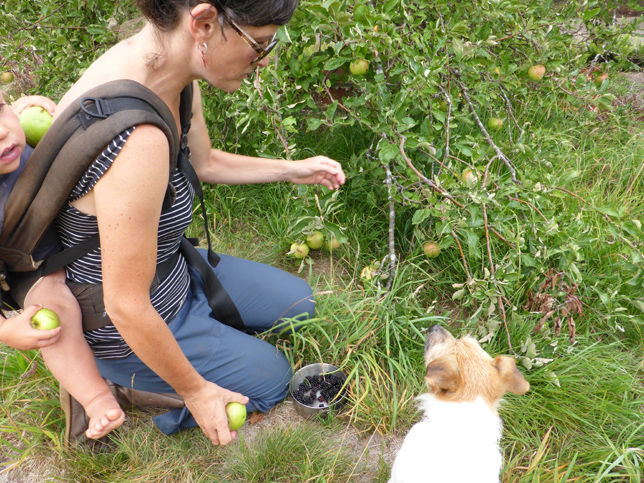
The Echigo-Tsumari Art Triennial in Japan (hereafter ETAT) is a more complex case to discuss. It is a visionary and socially engaged art project in its own right, informed by the environmentalist and anti-capitalist ethic of founder and director Fram Kitagawa, and an ensemble of discrete projects that have been selected because they amplify that ethic (Kitagawa 2015; Matsuo 2015; Klien 2010).[iii] Founded in 2000, ETAT is staged over the summer months and sits somewhere between a cosmopolitan art event, popular folk festival, permanent museum, and exhibition. The Echigo Tsumari region covers roughly 750 square kilometres in Niigata Prefecture and is very mountainous, experiencing extremely heavy snowfalls in winter. Residents’ livelihoods historically revolved around rice farming and other village economies like Kimono, soba noodles and tofu production. This area has experienced rapid depopulation, and many villages now only have a handful of permanent residents and few, if any, children. The Triennials have seen hundreds of permanent and temporary artworks installed in empty houses, schools and fields, with artists often working collaboratively with villagers to create them. Several imaginatively conceived museums – both purpose built and adapted from school buildings – now exist in the area.
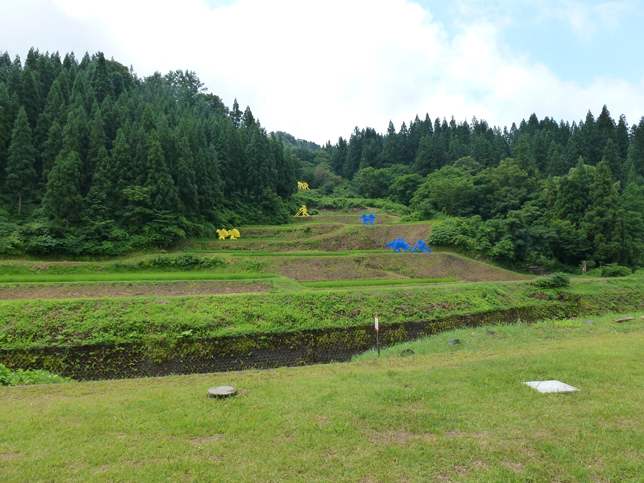
Echigo-Tsumari art field, Matsudai with ‘The Rice Field’, by Ilya and Emilia Kabakov (2000). Photo: Laura Fisher
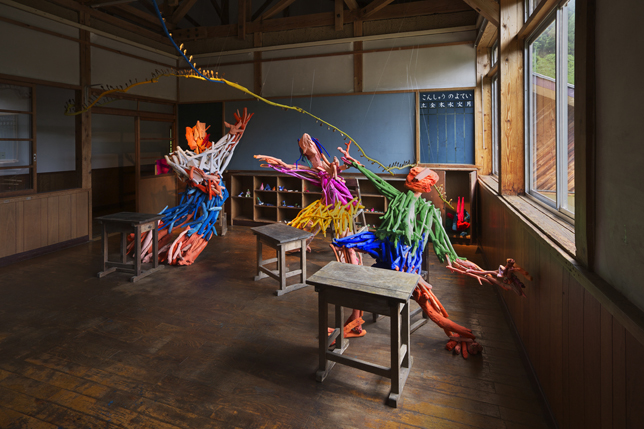
Hachi and Seizo Tashima. ‘Museum of Picture Book Art’, installation detail (2009-2015). Installed in Sanada Elementary School, which closed in 2005. Photo: Takenori Miyamoto and Hiromi Seno.
ETAT is widely distributed as an art ‘field’ to compel visitors to tour these sparsely populated areas. It is thus impossible to view the artworks in isolation from either the verdant mountains and rice paddies, or from the forms of labour with which the majority of visitors, (both Japanese and international), are disconnected: farmers and village residents, many of them quite elderly, tending to rice fields, orchards and large vegetable gardens.
The specific ETAT project to which I will refer in this article is the “Homestay Museum” by artist Takafumi Fukasawa. This work was displayed as an indoor installation; however this was only the material component of a socially-engaged art project that involved bringing 30 young people to stay for one or two nights with residents of villages in the region. Fukasawa found these participants, young people from Tokyo and other towns and cities, by issuing a call-out through his blog. As the introductory text states (this was the English translation that was displayed in the installation space):
Our volunteers stay in different houses in the villages of Echigo-Tsumari, participating and researching daily life there… documenting the various unique stories of the families with whom they stay. The researchers then, by borrowing documents and using other methods, come up with ways to store the stories and information they have gathered. It is from this information that the displays at Homestay Museum are constructed.
Thatched roofs, food preserves, straw craftsmanship and carp cultivation were among the skills that engaged the homestayers.
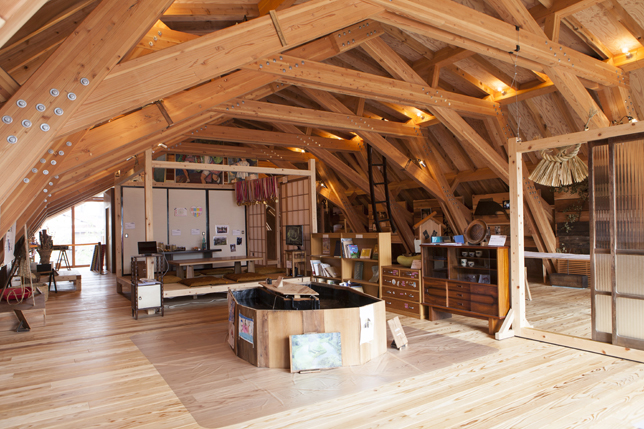
Takafumi Fukasawa, Homestay Museum, installation view, Ikote, Tokamachi (2015). Photo: Takafumi Fukasawa.
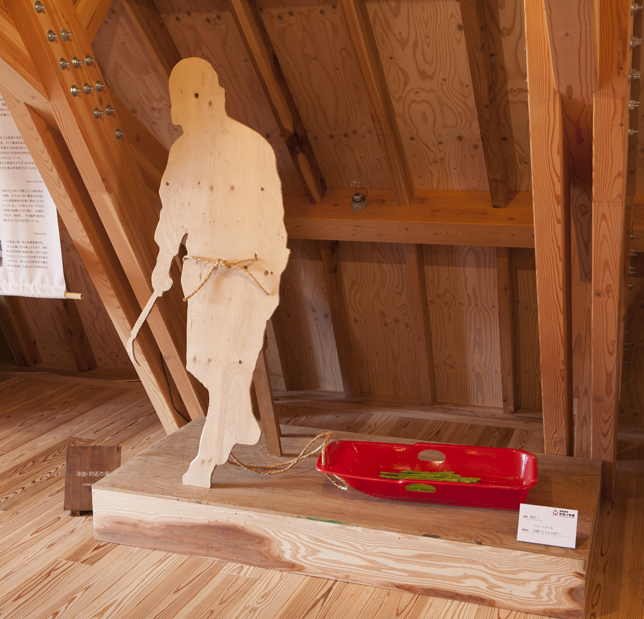
Takafumi Fukasawa, Homestay Museum, installation view, Ikote, Tokamachi (2015). Photo: Takafumi Fukasawa
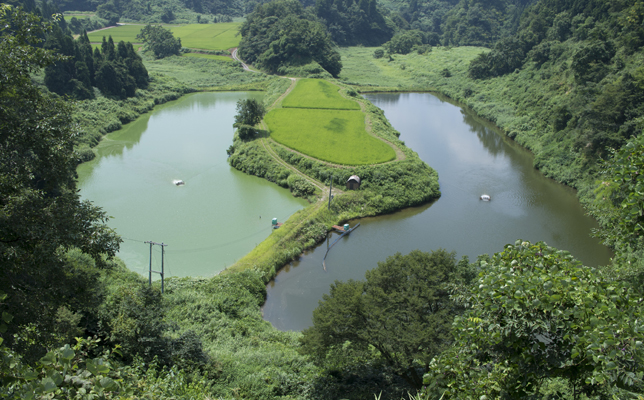
Carp Hatcheries of Koshirakura (2015). Homestay Museum location. Photo: Takafumi Fukasawa
In sum, the projects of Diego Bonetto, Artist as Family, ETAT and Takafumi Fukasawa all draw attention to practices of labour that mediate the relationship between self and land. They are affiliated by their concern with food cultivation and gathering, and their more or less explicit critique of urban capitalist food systems. Artist as Family, for example, see themselves as engaged in ‘a performance of living, increasingly, in a generative, non-monetary economy’, one enabled by ‘redressing our own peasant and Indigenous narratives’. They remind us that a conceptual threshold of possibility can be crossed if we remember that ‘all of us have come from ecological cultures’, and recognise that we are not as divorced from that history as we might imagine. This is equally true of Diego Bonetto who works from the simple premise, now made radical in an urban context, that ‘humanity at large should concern itself about the production of food’. He recognises that weeds provide him with a subtle but penetrating strategy to ‘transcend politics and inhabit culture, through food, medicine and migrant stories’. In the case of Fukasawa, he wanted the homestayers to have first-hand experience of the way the communities of Echigo Tsumari have ‘a wealth of land-based resources and make good use of them in the way they live’. This characterisation is a fair summation of satoyama, a centuries-old but now extremely marginal way of life in Japan where small-scale agriculture interpenetrates with the mountains.[iv]
Rediscovering ‘economy as ecology’
A very interesting configuration of artistic work is displayed in this suite of projects. While they extend upon a significant lineage of art concerned with revaluing manual labour, they are distinguished by the way they embed food in explorations of how ethical departures from neoliberal capitalism might be devised.[v] The activities of Bonetto and Artist as Family in particular can be understood as exercises in decommodification: the process by which the resources (material, affective, intellectual) we need to live well circulate beyond the marketplace. As Leigh Clare La Berge has recently argued, decommodification is a useful concept for illuminating the practice of socially engaged artists who assert the primacy of place, ethics and mutually supportive social relations and seek to restore the commons. As she suggests, ‘if decommodification is the removal of land, labor, or money from markets-based circulation, then many artists are already working within its historical ambit’ (2015: 580).
While many artistic responses to the predicament of the natural world employ environmentalist tropes that depict human economies as unerringly damaging, these projects introduce us to functional ways of relating to land. Their aesthetic is not dystopian or remedial, but has a political economic character. They aim to build corporeal knowledge of how each of our labours is implicated in environmentally damaging ways of being and can be recast. We might see this approach as possessed of the ethos of ‘livelihood-making,’ a concept Gibson-Graham and Miller propose as an alternative to conventional economic thinking. As they ask: ‘what if we were to see economic activities not in terms of a separate sphere of human activity, but instead as thoroughly social and ecological?... What if we were to see the economy as ecology?’ (2015: 8). The practice of Artist as Family exemplifies this ‘economy as ecology’ most comprehensively, however Diego Bonetto’s food tours and ETAT manifest such an ethos as well.
In the remainder of this article I will address these dimensions of the projects from two angles. First, I will consider how they are engaged in knitting together practices and ways of seeing the world that we are predisposed to see as temporally and spatially estranged through our perception of the rural and urban. And second, I will explain how they do this by dispensing with art and operating in an expanded field of culture, and consequentially reveal the elisions that pervade urban intellectual consciousness and inhibit our capacity to change our relationship to land.
If we were to plot where the obstacles to achieving economy-as-ecology lie, a critical starting point would surely be the structural and social differentiation of the urban and the rural, and the subjugation of the latter to the former. Let us return to ETAT, which was initiated to respond to precisely this problem. Japan experienced an extremely accelerated process of urbanisation: over the course of the twentieth century the urban population rose from 15% to 80%, and in 2014 it was reported to be 93% (Young 2013: 246; WorldBank 2016). During the Meiji Restoration (the half-century prior to WW1) the Japanese Imperial administration brought roughly two centuries of isolation from the world to a close, embraced western capitalist values and began an expeditious program of industrialisation. Modernisation continued apace through both world wars. As Young writes, by the late twentieth century ‘Japan became a creditor nation and global financial centre (along with London and New York), and industrial planning shifted to the new frontier of high-technology and information systems’ in Tokyo and other cities (2013: 247). These phases of transition ripped apart local agrarian economies and starved them of support. In the words of ETAT founder Fram Kitagawa:
The rural areas sent resources to the centre to fuel industries and capital and economic growth. This created a disparity in wealth between these central regions, which became increasingly wealthy, and the rural areas facing the Japan Sea, which led to the term “ura-Japan” (back side of Japan) to describe the latter, including the region of Echigo-Tsumari (Kitagawa 2015: 26).
Despite having some of the most sophisticated traditions of food cultivation in the world, Japan is now heavily reliant on food imports. And while rice growing is subsidised, municipal governments make it increasingly difficult for people to live in these mountainous areas by centralising services and reducing infrastructure (Feldhof 2013). For Kitagawa, such policies amount to dispossession, sanctioned by the insidious bureaucratic discourse of efficiency.
Japan’s urbanisation is of course a particularly swift variation of modernisation processes that occurred globally. These processes have attenuated our relationship with land – both spatially and in our cultural imaginations (Pretty 2002: 170). As Gibson-Graham and Miller write, the ‘history of economic thought’ that underpins modern capitalism can be seen as a ‘discursive enclosure of ecological space analogous to – and, in fact, historically parallel to – the material and legal enclosure of commons from the 16th century to the present’ (Gibson-Graham and Miller 2015: 8). In his book Agri-culture, Jules Pretty describes what the commons in Europe comprised before the enclosures:
These were the common or open-field systems of cropland, which persisted for 1000 years, and the common management of wild resources, woodlands, pastures, wastes, rivers and coasts. In these systems, local people held rights for grazing, cutting peat for fuel (turbaries), cutting timber for housing (estovers), grazing acorns and beech mast (pannage), and fishing (piscary) (2002: 29).
It hardly needs to be said that this vision of the commons and its attendant labour patterns are exotic for most of us. As Hamilton writes of Sydney, alluding not only to farming labour but the ‘elsewhere labour’ of a globalised economy:
with manufacturing all-but gone from the inner city and peri-urban farmland on the fringes of the city gradually being consumed by suburban development, the material conditions that support and enable the lives of citizens benefiting from the CBD’s knowledge-economy are becoming increasingly remote (2015: 185. See also James 2014; Ihlein 2015).
The sociologist of culture and Marxist critic Raymond Williams tracked the literary expression of this process in Britain in his seminal book The Country and the City (Williams 1975 [1973]). Along the way he surveys 17th century pastoral poetry and literature, in which depictions of country idylls (landed estates) convey more about the anxious emotions stirred by the expanding metropolis than the social realities of rural England. A motif of this genre is an image of food as a miraculous gift from nature, a kind of providence that allusively glorified the Lord of the manor:
A charity of production – of loving relations between men actually working and producing what is ultimately, in whatever proportions, to be shared – was neglected, not seen, and at times suppressed, by [the] habitual reference to a charity of consumption, an eating and drinking communion, which when applied to ordinary working societies was inevitably a mystification (Williams 1975 [1973]: 31).
Williams make the compelling suggestion that in this literature, the ‘curse of labour’ was expunged by ‘the power of art’ (32). Today the mystification Williams describes takes on a different, but equally pernicious guise in affluent urban economies. Now the labour of food production is expunged from our consciousness by the seductive propaganda of consumerist visual culture and the manipulation of ideas around choice, taste and the quest for novel and varied experience. The images of the ‘rural’ that do circulate in our popular culture are often sentimental parodies of farming, ‘a spatial imaginary increasingly detached from agrarian spaces per se’ (Gorman-Murray, Darian-Smith and Gibson 2008).[vi] City-dwellers’ knowledge of agricultural systems pertains to the newsworthiness of droughts, floods, health scares and other crises. Many such crises highlight how scientific innovations and marketised methods whose geographic anchor is decidedly urban have been exported to rural areas since the enclosures began, transforming farming methods in ecologically damaging ways: through the breakdown of small landholdings and the embrace of chemically-subsidised monoculture agriculture to extract larger and larger yields (Pretty 2002: 104–111; Williams 1975 [1973]: 60, 82–83).
The degree to which the city has colonised the country in these ways was made disquietingly obvious in an anecdote shared by Artist as Family from their east coast bicycle journey living off the land. While in North Queensland they passed a sugarcane farm with a fruit orchard in which there was abundant fruit. They knocked on the door to ask if they might harvest some of the fruit. The farmer replied ‘go for it,’ and dismissively declared that the orchard had been planted by a female relative years ago but that ‘no one ever goes down there anymore’. Artist as Family relied upon such unharvested food all along their journey. Their wilful exposure to hunger, heightened by the physically strenuous experience of riding, sensitised them to the absurdity of this waste and the fact that the links between farming and subsistence have been eclipsed by the monopolistic food distribution system of the supermarket.
Futurist taskscapes
All the art projects surveyed here either seek to rehabilitate a more direct relationship between food, human labour and survival, or honour the people whose lives revolve around that relationship. Tim Ingold articulates a neutral description of labour which can assist us to clarify this configuration of creative work: ‘I shall adopt the term ‘task,’ defined as any practical operation, carried out by a skilled agent in an environment, as part of his or her normal business of life’ (2000: 195). Ingold points out that tasks are necessarily ‘embedded in currents of sociality’ and proposes the term taskscape to refer to the ‘entire ensemble of tasks in their mutual interlocking’. In his characteristic lucidity about the social, material and spatial contingency of our sense of self, he writes that the ‘taskscape is to labour what the landscape is to land’.
Ingold’s concept of ‘taskscape’ invites us to reflect on the constitution of subjectivity within our cityscapes, and to question how our labour - the investment of our ‘mutually interlocking’ physical, emotional and intellectual energy - translates into survival and quality of life. It invites us to compare the taskscapes described by Pretty and Williams with those of urbanised societies. In affluent societies, the latter are so abstracted from our means of subsistence that we now have a very degraded vision of manual labour.[vii] More than this, as ecofeminist philosopher Val Plumwood writes, the post-industrial configurations of labour that sustain urban knowledge economies ‘erase the agency of the more-than-human sphere, cause us to misunderstand our lives, and thus engender a false consciousness that justifies appropriation’ of that sphere (2008).
Ingold’s proposition allows us to recognise that the artists discussed here deploy their artistic labour to resocialise taskscapes that western capitalist culture has displaced and devalued. For example, ETAT brings people from the cities and suburbs of Japan back into an environment in which people – like many of their own forbears – remain subjectively invested; a space where they are economically reliant upon resources that arise from symbiotic interactions of the human and non-human. The Homestay Museum enables a more embedded encounter with village livelihoods. As Fukasawa Takafumi describes:
Yesterday we had a homestay and seven of us went to a village called Tanugi. The village has about thirty households and for example, after the Chuetsu earthquake, villagers used their own heavy machinery including tractors to do their own repair work after a minor landslide. They have their own home vegetable gardens, whose scales are actually quite big. They grow as much as 1,000 potatoes even though they only eat them themselves.
So they have their own agricultural produce, their own power generators and propane gas, and each house has a gas cylinder. So even at the time of a natural disaster, they don’t touch distributed food and they manage themselves.
So on one hand, they have this pre-modernization self-sufficiency and the life they’ve built on this land in a heavy snowfall region. On the other hand, they went through modernization and industrialization. These characteristics are now mixed together here, like two blood streams mixing together. In that sense, they are very futuristic.
The term ‘futuristic’ is key here, and seems pertinent to the peculiar temporality – the marriage of progressive values with a retrospective orientation – that underlies all of the projects discussed here. Fukasawa’s words situate well-established traditions of resilience and collectivism, retained by a small group of elderly residents, in the temporal frame of contemporary survivalism. They evocatively take people supposedly left behind by history and relocate them in front of history. These are the residents who did not follow the directives of their schoolteachers and lasso themselves to the juggernaut of Japanese technological advancement and urban growth. And it is only the mountainous geography of the region that has exempted them from the nation-wide usurpation of land that has seen agrarian locales that had ‘formerly been autonomous, self-sustaining villages became orbital communities and extensions of the urban economy’ (Young 2013: 104–105). Yet now these residents become antecedents of a global environment-conscious community, bearers of knowledge and skills desired by a youthful generation sensitized to food and energy sustainability (this has particularly been the case since the Fukushima nuclear disaster in 2011).
A form of survivalism is also central to the taskscapes enacted by Artist as Family. By pursuing subsistence living they model a way of life that brings the environmental crisis that the rest of us keep at the fringes of the everyday into the spheres of the body, the family and the dwelling. To use Plumwood’s (2008) words, they are testing what it means to allow nature to be ‘an active agent in and co-constituter of [their] lives’. Through their blogging, book writing and appeals to the hospitality of strangers on their journeys, they disclose the vulnerability of this exercise: the elemental experiences of exhaustion, pain, hunger and fear (of careless drivers on the roads, wild dogs in the forest, or of it being too dark to find food for dinner) to whoever chooses to allow it to affect them.
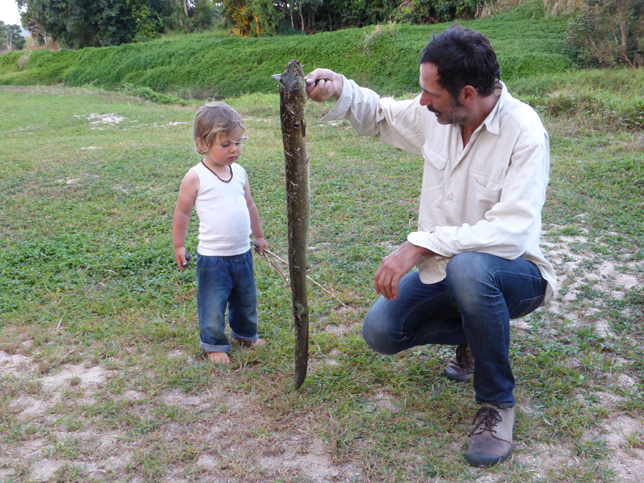
Artist as Family, Woody and Patrick examine an eel Patrick has caught at Babinda, QLD (NSW). Photo: Meg Ulman.
Dispensing with the urban cultural geography of art
Having explored how these projects perform and illustrate less mediated relationships between labour and survival, I wish to turn to a further meaningful critique they embody: the complicity of aspects of contemporary artistic and intellectual culture in the appropriative and prejudicial ideas about the rural that circulate in urban culture. This is a problem to which the Spanish-born artist Fernando García Dory has turned his attention over many years, through his leadership of participatory projects relating to sustainable food production, agro-ecology and solidarity among nomadic pastoralists (Dory 2011). Describing Spain he writes:
we have an art system that only looks to the city as fertile ground for inspiration, intervention, and circulation. This is based in ignorance, if not disdain, of other environmental configurations, including the rural. Yet the rural is actually a low-density urban realm where nature breathes a bit more through the interstices. The exploration of these interstices gives us the possibility to experience another way of life, which has been embodied by indigenous and peasant cultures. … these cultures, now more than ever, have to be reconsidered or reinvented. As such, if I try to undermine anything, it is the brutal shortsightedness of the urban lifestyle and the way it looks down on the rural (Fite-Wassilak and Dory 2011: 26).
In his reference to the ‘art system’s’ exclusionary focus on the city, Dory reminds us that the corpus of artistic and utopian ideas from which many contemporary artists draw inspiration (and their declared environmental politics) has a decidedly urban cultural geography. They depend upon the dense aggregation of activities and dialogues that is characteristic of the metropolis. They also arise from a kind of sociality whose disenchantment with capitalism often rests upon an enchantment with the natural world and, as Raymond Williams documented so thoroughly, an idealisation of the pastoral (Williams 1975 [1973]; Gorman-Murray, Darian-Smith and Gibson 2008; Sutherland 2011). In Australia, an urban environmentalist consciousness tends to be associated with regular escapes to the country and to the bush, and an admiration for Indigenous ecological knowledge – but also an inability to imagine living ‘out there’ (or failed attempts to do so). As Gibson writes, this means that ‘small and remote places run the risk of perennial peripherality – especially when attitudes to certain places as ‘culturally arid’ persist’ (Gibson 2012: 4). In this impasse is inscribed inequalities of education and class, the decline of rural economies that leaves areas depopulated, a fear of social isolation and poor access to infrastructure, and so on. What Dory’s assertion, and the projects discussed here, reveal, is that our criticality as artists and intellectuals does not make us any less susceptible to urbanisation’s conditioning of our subjectivity. Recognising that the subordination of the rural to the urban infuses our shared intellectual practices may provide an important reflexive boost to our creative and ethical responses to environmental imperatives.
After Dory’s critique it is pertinent to recall that it was the industrial revolution that inspired the dissociation of art from the everyday (Shiner 2001). The Romantics perceived the assault of industry and the market economy upon the bonds of human fellowship to be so severe that art was apprehended in a new light: as an unpolluted wellspring of those values to which we might keep returning to rescue ourselves from a morally impoverished world. And yet this established a privileged and restrictive landscape of art creation and validation, or in Diego Bonetto’s terms, ‘[the art world] just keeps extrapolating, isolating, alienating its own produce from the actual subject of its own investigation!’ Like Dory, Bonetto, Artist as Family and Fram Kitagawa all adopt an impious attitude towards the normative discourses and validating mechanisms of the art world. They all draw intellectual courage from a mix of artists, poets, philosophers and activists who were, or remain, comfortable with working in the ambiguous space where art and everyday life converge in order to reach a public that the majority of those in the art world view as apathetic or indeed hostile to art. As Bonetto related in our interview, conceptual art gave him the ‘critical capabilities’ to anchor his activist principles in a shrewd language and set of methods. However: ‘I don’t care about the aesthetic value of weeds! I care about the cultural value, I care about culture, and I kept coming back to the etymology of culture which is growth.’ He views his tours as vehicles for an activist agenda that does not need to justify itself according to aesthetic scruples or principles of autonomy, and in our interview he appropriated the semantics of commerce to explain his methods:
Let’s engage in the exponential growth of your audience. When you engage in the exponential growth of your audience – to facilitate an art practice that can support you – you need to adapt, craft, shift your discourse, the way you present whatever you have to offer, so that you can accommodate the tastes of the extra audience, the audience outside the art department.
To achieve this, Bonetto confidently manoeuvres within the formats of mass media story-telling, marketing and celebrity to promote his tours (which are ticketed, providing him with an income). While some in the art world would disavow this activity as overly commercial, Bonetto regards it as critical to the efficacy of his environmental politics. He locates his performative practice in relation to a history of storytelling in the public domain that dates back to the Cantastorias (Italian “story-singers”) of medieval times as well as jesters, travelling players and the likes of Dario Fo. A contemporary ‘hero’ is the charismatic Costa Giorgiadis, the Australian landscape architect and ABC TV presenter. As Bonetto says of his own somewhat comical public persona, there is power inherent to playing the fool: ‘you know the jester, astonishingly, was the only one who could say the truth to the King.’
Like Bonetto, Artist as Family identify with the latin concept of culture ‘cultura’: to ‘cultivate the earth’. As member Patrick Jones has written ‘[i]n the pre-agricultural era – which spans the great majority of human history – when foraging was the main food generating form, ‘culture’ wasn’t perceived and studied, rather experienced and embodied in the logic of the land’ (Jones 2010). The artistic heritage they look to in their biophysical performance are the works of John Cage, Richard Long and the Fluxus artists (Walton-Healey and Wilkinson 2011). As for Kitagawa, he explicitly identifies ETAT as taking an approach that ‘serves the public and incorporates art into life,’ and the practices of satoyama remain the cornerstone of his interest in the vital functional-creative linkages that bind people to land (Kitagawa 2006; Tsubioke 2009; Kitagawa 2015: 222, 240. Takafume Fukusawa’s “Homestay Museum” revolves around the power of direct experience. He notes that ‘ultimately what inspires artists here [who participate in ETAT] is the way of life and the land, which are then expressed in another form and fit into a framework in most of the artworks. So why not create direct access to the original source of inspiration?’
Conclusion
Food is an inexhaustible site of hope for environmentalist projects. It holds the promise that we can recalibrate our relationship with natural systems and that new kinds of earth-literate subjectivities can be formed. The art projects explored here all manifest a political economic critique of labour, and introduce economy-as-ecology possibilities to their participants. I have argued that they are compelling projects because they synergise methods of living that we habitually see as geographically, temporally and culturally differentiated. They marry a form of enlightened retrospectivity with a progressive and sometimes survivalist orientation in order to awaken an awareness that subsistence practices are within reach of all of us.
It might seem paradoxical that having started with Tim Ingold’s argument that ‘[o]ur actions do not transform the world, they are part and parcel of the world's transforming itself’, I have surveyed art projects that focus the mind upon our individual agency in everyday life. In the twenty-first century the world is transforming itself through a maelstrom of rebounding human and non-human forces that are beyond most of our comprehension. This predicament would seem to underscore the futility of individual acts of agency. Yet to speak of art at all in situations of crises is to accept that it in fact draws its energy from this paradox: artists stubbornly preserve an agency-affirming idealism no matter the circumstances. I have singled out these projects because their democratic approach to culture, creativity, knowledge and skill, and their emphasis on actions and experience, astutely target the process by which human subjectivity is formed through physical interaction with the non-human. The forms of agency these artists advocate are precisely about placing oneself within functional environments and structures that dispel, to recall Plumwood, the ‘false consciousness that justifies appropriation’ of the non-human. Food is here a tool for loosening the mainstays of urbanised subjectivity and appealing to the most elemental means by which we can attain some objectivity about not only our fatal annexation of natural resources but our mass capitulation to a matrix of consumer-capitalist ideas around how to live well. Practices of subsistence sit very awkwardly in an urban context because, as Raymond Williams writes, capitalism ‘succeeded in transforming [the agrarian] environment in a dramatically productive way, by making both [people] and nature instrumental to a dominant purpose’ (1975 [1973]: 82). Yet awkwardness is always a fertile site for friction and mobility. Probing that awkwardness opens up spheres of autonomy and responsibility that can be a starting point for an ethic of living based upon the idea of economy-as-ecology. The forms of creative work exemplified by the projects discussed here show us that, if we are to ever unravel the unsustainable taskscapes of the modern economy, it is likely that a rediscovery of life-affirming practices of labour will have had something to do with it.
Acknowledgements
The author wishes to thank Diego Bonetto, Meg Ulman, Patrick Jones and Fukusawa Takafumi for generously sharing their ideas in our interviews. Thanks also to the two anonymous reviewers and editor Scott Brook for very helpful comments on earlier drafts. This research was assisted by Sydney College of the Arts, the University of Sydney.
[i] I spent two weeks at the Echigo Tsumari Festival in July/August 2015, during which I viewed the Homestay Museum installation twice and interviewed Fukusawa Takafumi (along with other artists, organisers and local residents of the region). I participated in two of Diego Bonetto’s Wild Tours in Sydney on 3 November 2015 and 6 December 2015, the latter of which played host to Artist as Family as expert foragers.
[ii] Unless otherwise stated, quotations from the artists are drawn from the following interviews with the author: Diego Bonetto, 2 February 2016, Artist as Family, 12 August 2015, Takafumi Fukusawa, 3 August 2015. The latter interview was conducted with the aid of an interpreter, and the audio recording translated from Japanese to English when transcribed.
[iii] Prior to establishing ETAT, Fram Kitagawa had an extended career of environmental activism and critical writing regarding 19th and 20th century industrialisation in Japan, in relation to the Ashio Copper Mine’s devastation of irrigated land and waterways and the victims of Minamata Disease (caused by mercury poisoning in fish) (Monsma 2015, Matsuo 2015).
[iv] Inherent to Satoyama ecologies is the harvesting of forest materials for food, fertiliser, clothing, construction, heating and pottery, as well as the contouring and tunnelling of waterways to irrigate rice paddies. Thus the forest environment is shaped and regenerated through human use (Kobori and Primack 2003). It’s important to acknowledge that the Satoyama heritage of the Echigo Tsumari region is now adapted to the use of pesticides and electrified tools and the availability of consumer goods.
[v] See the path-breaking performances (in the 1960s, ‘70s and ‘80s) of New York artist Mierle Laderman Ukeles around domestic, parenting and public maintenance labour, and more recent examples like Sophie Hope and Jenny Richards’ project Manual Labours and the Utrecht-based Casco collective’s Composing the Commons exercises (Jackson 2011, Casco 2016).
[vi] Such imaginaries do sometimes become oppressively consequential in terrestrial space as well. In a tragicomic tone, Grizedale Arts’ founder Adam Sutherland argues that this has eventuated in the much visited farmland in the English Lake District: ‘The image of farming, promoted by the leisure industry, has now turned on its originator and started to manipulate the reality to conform to the lifestyle vision of multinational design chains, marketing campaigns and tourism agendas’(Sutherland 2011, 98).
[vii] Kathyrn Yusoff has written that Margaret Thatcher’s victory over the UK miner’s strike of 1984-1985, when coal subsidies were withdrawn in favour of imports leading to the impoverishment of British mining towns, was partly achieved by ‘joining forms of physical labour to social humiliation’ (Yusoff 2015, 219). The demoralisation that followed from the failed strikes marks an important moment in Britain’s path to neoliberalism, for which the suppression of social democratic movements and the belittlement of manual labour and working class collectivism was so essential.
Artist as Family 2016 http://theartistasfamily.blogspot.com.au/ (accessed 19 April 2016)
Bonetto, D 2016 ‘About’ page http://www.diegobonetto.com/about/ - bio (accessed 19 April 2016)
Casco 2016 'We are the time machines: time and tools for commoning', 18 January http://cascoprojects.org/we-are-the-time-machines-time-and-tools-for-commoning (accessed 19 April 2016)
Dory, F G 2011 Images of Farming, edited by Wapke Feenstra and Antje Schiffers, Heijningen: Jap Sam Books
Feldhoff, T 2013 ‘Shrinking communities in Japan: Community ownership of assets as a development potential for rural Japan’, Urban Des Int 18: 1, 99–109
Fite-Wassilak, C and Garcia Dory, F 2011 ‘Beneath the Bureaucracy, The Beach: An Interview with Fernando Garcia Dory’, Art Papers 35: 1, 24–29
Gallagher, B 2012 On a food hunt with Diego, Reportage online
Gibson, C 2012 ‘Introduction - Creative Geographies: tales from the margins’ In Creativity in Peripheral Places, edited by Chris Gibson, London: Routledge, 1–10
Gibson, K, Bird Rose, D and Fincher, R (eds) 2015 Manifesto for living in the Anthropocene, Brooklyn, NY: Punctum Books, v-viii
Gibson-Graham, J K and Miller, E 2015 ‘Economy as Ecological Livelihood’, in K Gibson, D Bird Rose and R Fincher (eds) Manifesto for Living in the Anthropocene, Brookyln, NY, Punctum Books, 7-16
Gorman-Murray, A, Darian-Smith, K and Gibson C 2008 ‘Scaling the Rural: Reflections on Rural Cultural Studies’, Australian Humanities Review 45
Hamilton, J 2015 ‘Labour’, Environmental Humanities 6, 183-186
Ihlein, L 2015 ‘The Yeomans Project: Peri-urban field work’, Axon 8
Ingold, T 2000 The Perception of the Environment: Essays in livelihood, dwelling and skill, London and New York: Routledge
Jackson, S 2011 Social Works: performing art, supporting publics, New York & London: Routledge
James, S W 2014 ‘Protecting Sydney's Peri-Urban Agriculture: Moving beyond a Housing/Farming Dichotomy’, Geographical Research 52: 4, 377-386
Jones, P 2010 ‘Primitive Futures’, in M Jokiranta (ed.) Seven Thousand Oaks catalogue, Melbourne: Seven Thousand Oaks
Jones, P, and Ulman, M 2015 The Art of Free Travel, Sydney: NewSouth Publishing
Kitagawa, F 2006 ‘An Encounter: Satoyama and Contemporary Art’, in Echigo-Tsumari Art Triennial 2006, Niigata-ken, Japan, 7–9
Kitagawa, F 2015 Art Place Japan. New York, NY: Princeton Architectural Press
Klien, S 2010 ‘Contemporary art and regional revitalisation: selected artworks in the Echigo-Tsumari Art Triennial 2000–6’, Japan Forum 22: 3-4, 513-543
Kobori, H, and Primack, R B 2003 ‘Participatory Conservation Approaches for Satoyama, the Traditional Forest and Agricultural Landscape of Japan’, AMBIO: A Journal of the Human Environment 32: 4, 307-311. doi: 10.1579/0044-7447-32.4.307
La Berge, L C 2015 ‘Wages against Artwork: The Social Practice of Decommodification’, South Atlantic Quarterly 114: 3, 571-593
Matsuo, A 2015 ‘The Optimistic Vision of Kitagawa Fram and the Echigo-Tsumari Art Triennale’, Kyoto Journal 82, 1-10
Monsma, B 2015 ‘Echigo-Tsumari and the future of Satoyama’, Kyoto Journal 82, 31-43
Plumwood, V 2008 ‘Shadow Places and the Politics of Dwelling’, Australian Humanities Review 44
Pretty, J 2002 Agri-culture: reconnecting people, land and nature, London: Earthscan
Rosler, M 2013 Culture Class, Berlin: Sternberg Press
Safe, G 2015 ‘Forager Diego Bonetto reaps the benefits of edible weeds’, Sydney Morning Herald, July 8 http://www.smh.com.au/nsw/forager-diego-bonetto-reaps-the-benefits-of-edible-weeds-20150707-gi6pho.html (accessed 21 November 2016)
Shiner, L 2001 The Invention of Art: A Cultural History, Chicago: University of Chicago Press
Sutherland, A 2011 ‘Abuse me again and this time really slowly so that I can really get a feel of it’, in W Feenstra and A Schiffers (eds) Images of Farming, Heijningen: Jap Sam Books, 94-101
Tsubioke, E 2009 ‘Presenter Interview: Art bringing hope to Echigo-Tsumari - the ongoing journey of Fram Kitagawa’, Performing Arts Network Japan
Walton-Healey, N, and Wilkinson, J L 2011 ‘An interview with Patrick Jones’, Rabbit 2, 132-154
Williams, R 1975 [1973] The Country and the City, Oxford: Oxford University Press
World Bank 2016 ‘World Development Indicators: Urbanisation’ http://wdi.worldbank.org/table/3.12 (accessed 21 November 2016)
Young, L 2013 Beyond the Metropolis: second cities and modern life in interwar Japan., Berkeley and Los Angeles, CA: University of California Press
Yusoff, K 2015 ‘Queer Coal: Genealogies in/of the Blood’, philoSOPHIA 5: 2, 203-229